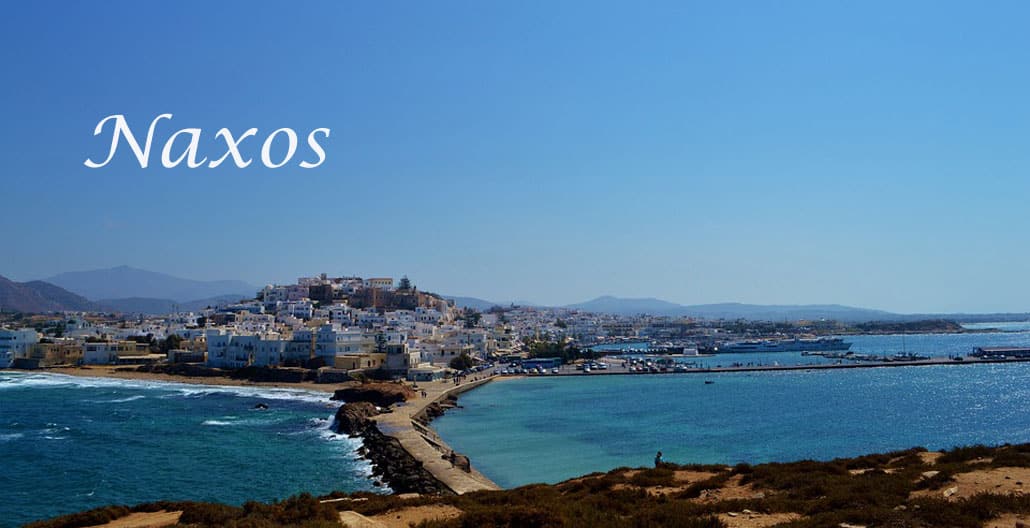General informarion about Naxos island
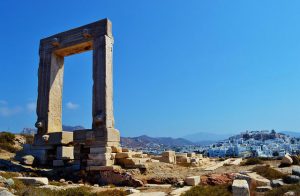
Naxos has always followed the fate of the Aegean islanders’ adventures. A destiny intertwined with voyages, exchanges, new techniques, pioneering ideas, but also wars and conflicts for maritime dominance..
Naxos is a paradise for nature enthusiasts, with a diverse landscape that ranges from rugged mountains to fertile valleys and golden sandy beaches.
The island’s highest peak, Mount Zas, offers breathtaking panoramic views, while the lush greenery of the Tragea Valley creates a serene backdrop for leisurely walks and hikes.
Naxos is also home to impressive cave formations, including the famous Cave of Zeus, where mythology comes alive.
With over 40 stunning beaches lining its coastline, Naxos spoils visitors with its incredible variety. From long stretches of golden sand to secluded coves with turquoise waters, there is a beach to suit every taste.
The popular beaches of Agios Prokopios and Plaka boast a vibrant atmosphere, while hidden gems like Agia Anna and Mikri Vigla provide tranquility and solitude. Whether you’re seeking sun-soaked relaxation or thrilling water sports adventures, Naxos has it all.
Naxos in Greek Mythology

Ariadne fell in love with Theseus and helped him navigate the treacherous Labyrinth to defeat the Minotaur. After their triumph, they fled Crete together but stopped on the island of Naxos.
It is said that Theseus abandoned Ariadne on Naxos while she was sleeping, as instructed by the gods. Dionysus, the god of wine and ecstasy, discovered Ariadne and fell in love with her. They were eventually married, and Naxos became a significant site of worship for Dionysus.
Dionysus, the son of Zeus and Semele, was closely associated with Naxos. According to mythology, Dionysus discovered the vine and introduced winemaking to the island. Naxos became known for its fertile land and bountiful vineyards, and Dionysus was worshipped as the god of wine, fertility, and celebration on the island. The island’s wine production and Dionysian festivals were an integral part of Naxian culture.
In another myth, Zeus saved the unborn Dionysus by sewing him into his thigh after his mother, Semele, was consumed by lightning. The young Dionysus was then reborn from Zeus’ thigh. It is believed that Naxos, with its lush and fertile landscapes, was chosen by Zeus as the birthplace of Dionysus due to its natural abundance and connection to wine production.
History
Naxos has been inhabited since the Neolithic period, around 4,000 BCE. It was an important center of the Cycladic civilization and known for its flourishing trade and maritime activities. The island was conquered by various ancient civilizations, including the Minoans, Mycenaeans, and Persians.
In the 6th century BCE, Naxos became a significant maritime power under the tyrant Lygdamis. The island prospered and played a prominent role in the Delian League, an alliance of Greek city-states led by Athens. During this time, the famous Temple of Apollo was built, which became a symbol of Naxos.
Naxos witnessed a turbulent period during the Byzantine Empire. In 1207, the island fell under the control of the Venetians, who established the Duchy of the Archipelago. The Venetians ruled Naxos for several centuries, and their influence can still be seen in the island’s architecture and fortifications.
The Ottoman Empire took control of Naxos in 1566, ending the Venetian rule. Under Ottoman rule, the island’s population suffered from piracy and economic decline. However, Naxos maintained its cultural and religious identity throughout this period.
During the Greek War of Independence in the early 19th century, Naxos played a significant role in the struggle against Ottoman rule. The islanders actively participated in the revolution and contributed to the establishment of an independent Greece.
Naxos Geography
Naxos has a varied terrain characterized by a mountainous interior and flatter coastal areas. The island’s highest peak is Mount Zas, also known as Mount Zeus, standing at an elevation of approximately 1,004 meters (3,294 feet). The central part of the island is dominated by a range of mountains, while the valleys and plains are found in the coastal regions.
Apart from Mount Zas, other significant mountains on Naxos include Fanari (908 meters/2,979 feet) and Koronos (768 meters/2,519 feet). These mountains contribute to the island’s scenic beauty and offer opportunities for hiking and exploration. The mountainous terrain provides a striking backdrop to the island’s picturesque landscapes.
Naxos boasts a diverse and extensive coastline that stretches for approximately 148 kilometers (92 miles). The coast features a combination of long sandy beaches, rugged cliffs, and secluded coves. Some of the notable beaches on the island include Agios Prokopios, Plaka, Agia Anna, and Mikri Vigla. The coastline is also dotted with charming fishing villages, picturesque harbors, and small islets, adding to the island’s allure. Naxos has several natural harbors, such as Naxos Town (Chora), which is the island’s capital and main port.
Naxos is also the most fertile island of the Cyclades with many natural springs and agriculture, not tourism, playing the bigger role in the island economy.
The island is known for its crops of vegetables, notably potatoes, and for citrus, olives and cattle breeding. Naxos also produces cherries, cheese, nuts, pomegranates, figs and corn in the fertile valleys of Engares, Melanes and Potamia.
Naxos is fabled for its high quality marble and was once a major source of emery, the industrial remnants of which survive at Moutsouna on the east coast.
The landscape of Naxos is very varied, from high mountain ranges to lush fertile valleys. The highest peak is Mount Zas at 1,004 metres.
Local products and gastronomy
The plain with citrus fruits and vegetables, the olive groves, the vineyards in the northern part of the island, but also the livestock farmers of Filoti and Apirantho, supply supermarkets, traditional grocers and the good taverns of the island, where you can try apirathitiko roast (pork in a pot with garlic and wine), village rooster, pork fricassee with sheep, goat in various versions, but also seafood (fur, salaturi, marinated anchovies). The most famous products of the island are, of course, potatoes, milk and cheese (graviera, tulumotiri, kefalotiri) and liqueur and sweet citrus.
A typical Sunday Naxian table can include everything from amazing cheeses and fresh salads to roast goat with potatoes and vegetables and many other delicacies based on the “farm to table” philosophy. And of course they all have that smell that enchants you wherever you are and brings you memories of the past.
Zucchini and tomatoes, Naxos fried potatoes, peach jam, braised lamb with potatoes in a lemon and herb sauce in the wood oven, dolmades and pies, are just some of the dishes and recipes that every visitor will learn, taste and surely remember.
Naxos is famous for its high-quality cheese, particularly the variety known as “graviera.” Made from cow’s milk, this hard cheese has a rich, slightly sweet flavor and a golden-yellow color. Other local cheeses include “xynotyro,” a sour cheese made from goat’s and sheep’s milk, and “arseniko,” a strong and salty sheep’s milk cheese.
Marble holds cultural and historical significance, and its association with the island of Naxos adds to its allure. It is considered one of the notable marble varieties originating from Greece, renowned for its beauty, craftsmanship, and enduring legacy.
It is a type of marble that is found on the island of Naxos in Greece. It is known for its high quality and has been renowned since ancient times for its use in sculptures, architecture, and decorative elements.
Weather on Naxos
Naxos has a typically Mediterranean climate with dry summers and mild winters. In July expect up to 13 hours of sunshine daily and temperatures in the high 20s to a record maximum of 38°C.
Temperatures from June to September average 27-29°C by day and will top 20°C at night. Fresh seas breezes help to keep humidity down and it’s rare to see any rainfall.
Winter temperatures on Naxos hover around14-15°C by day and 9-10°C at night. Most of the rain falls in the winter months with the heaviest rain showers in December.
The town of Naxos
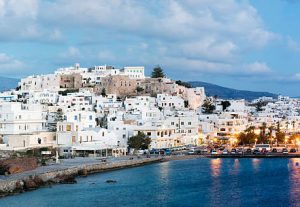
The Portara in Naxos Chora is the prime attraction, a grand marble gate on a tiny islet near the shore. Originally part of an incomplete temple to Apollo, this relic of antiquity offers stunning sunsets over the Aegean Sea that cannot be missed.
If you take a stroll through the narrow, stone-paved roads of the historic Venetian Quarter, you’ll come across captivating whitewashed homes and cozy stores selling both traditional handicrafts and mementos. Not to mention, some of the island’s highly acclaimed eateries!
Naxos Chora’s Archaeological Museum is home to many relics from the past, while the Kastro, a 13th century fortification, offers visitors an exciting glimpse into history.
Naxos town is renowned for its grand history and diverse cultural attractions, as well as its fabulous beaches. Located on the edge of a large bay, nearby are several inviting sandy shores like Agios Georgios Beach, Agios Prokopios Beach, and Plaka Beach.
Naxos Villages
The island is dotted with charming traditional villages that reflect its rich history and traditional way of life. The main town and capital of Naxos is Chora (also known as Naxos Town or Naxos Chora), located on the west coast. Chora is a picturesque town with narrow alleys, Venetian architecture, and the iconic Portara, a massive marble gate that remains from an unfinished temple dedicated to Apollo.
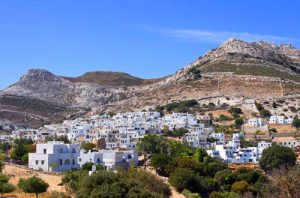
Wandering around the narrow marble streets, under archways and up whitewashed stone steps, is a great delight. Small piazzas crop up unexpectedly, sometimes housing a small taverna or street cafe. The chimneys are eye-catching too and the village roofs are called ‘the garden of strange flowers’.
Local handicraft is on sale and much of it is fine, local stuff. A women’s co-operative sells gorgeous, if pricey, handwoven textiles and there is a clutch of museums to visit. The archaeology museum has Cycladic figurines and slate drawings while the museum of popular art has some exquisite locally-made artifacts.
The Museum of Natural History is rather less well endowed with a few old bird nests, some bleached bones, pressed flowers and fish pickled in jars and all packed into a tiny room.
The village is noted for several varieties of cheese, although the stuff I bought in the local shop had the texture, colour and consistency of marble. The local dialect is a mixture of Cretan and ancient Greek and the village has, for some unaccountable reason, produced a great number of intellectuals and politicians.
Kouros
Filoti
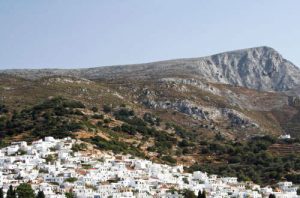
The tiny church of Agios Iannis can be seen perched on the mountain opposite and there is reputed to be a path up to the Za summit – if you can find it let me know. Zeus was born in a cave on Mount Za, they say, but it is a two hour trek up steep and poorly marked tracks and all you get for your trouble is a small cave with a smaller inner chamber, two large stalagmites and heat-stroke.
Filoti itself is little more than a single straight road on the side of the mountain – a tarmac terrace to take in the views. You leave the main road at your peril; dead end farm tracks are everywhere and signs are non-existent.
Filoti’s long, narrow street is lined with shops selling everything from saucepans to bagged sheep fleeces. A few roadside cafes offer refreshments and shaded tables and chairs cluster under large roadside plane trees.
The village also has an interesting church, Panagia Filotitissa, built in 1801 and containing some good icons, a marble iconostasis screen and a nicely carved bell tower.
Keramoti
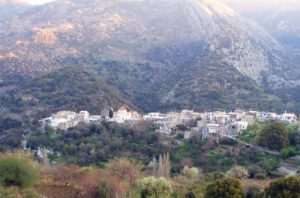
Keramoti is known for its lush greenery and traditional architecture. Visitors can explore the cobblestone streets, admire the stone houses and churches, and take in the stunning views of the surrounding hills and valleys.
One of the main attractions in Keramoti is the Byzantine church of Panagia Protothroni. This beautiful church dates back to the 9th century and features impressive frescoes and intricate marble carvings
Agia Anna
Located on the western coast of Naxos, Agia Anna is a popular beach village known for its long sandy beaches and crystal-clear waters.
The village offers a relaxed and laid-back atmosphere, with a variety of accommodation options, seaside taverns, and beach bars. Agia Anna is an ideal destination for beach lovers and those seeking a tranquil seaside retreat.
Agios Prokopios
Adjacent to Agia Anna, Agios Prokopios is another well-known beach village with a fantastic sandy beach stretching for several kilometers. The village features a wide range of accommodation options, restaurants, and beachfront bars. Agios Prokopios is a popular destination for water sports enthusiasts and families looking for a lively beach resort.
Apollonas
Situated on the northern coast of Naxos, Apollonas is a small fishing village known for its natural beauty and archaeological significance. The village offers a peaceful and relaxing environment, with a scenic beach and clear blue waters. Apollonas is also home to the famous Kouros of Apollonas, a colossal ancient statue that lies unfinished in the vicinity.
Village of Chalki
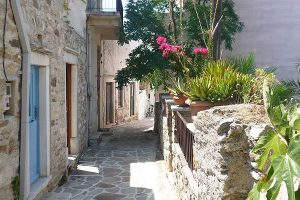
The village itself is a dusty, lifeless little place and somehow fails to live up to its reputation as one of the richest villages on the island. Guide descriptions such as ‘attractive’, ‘quaint’ and ‘lovely’ are hard to justify on the ground, among the dust and litter.
Chalki has many crumbling old mansion houses, recalling its more prosperous days and there are several old towers nearby such as Gratsias (or Barotsis), Papadakis at nearby Akademi and of Marcopolites at neighbouring Kerami.
Also of note is the old 19th century distillery where the ‘Citrus of Naxos’ liquor was famous not only on Naxos but the whole of Greece. Today they sell ouzo in the centre of the village.
The local churches are also worth a visit, notably Panaghia Protothrone, dating from the 9th century and the religious museum beside it with ritual relics as well as icons. Panagia Drossiani, one of the oldest and most important, is found on the right on the steep hill as you head towards the mountain village of Moni. Built between the 6th and 10th centuries BC it has rare wall paintings from the 9th century and wonderful views over the fertile Tragea valley.
Tragea is one of the most fertile parts of Naxos, full of olive trees and citrus orchards that produce the largest amount of the island’s agricultural products. Across the rolling hills are not only Halki but also the villages of Acadimi, Chimarros, Kaloxilos, Damalas, Damarionas and Tsilikario.
Culture and traditions
Naxos has a rich culture and unique traditions that have been passed down for generations. One of the most notable traditions in Naxos is the weaving of textiles. The island is famous for its intricate embroidery and lacework, created by skilled local artisans. In fact, Naxos’ weaving industry dates back to ancient times, and traditional techniques are still used today to create beautiful and intricate designs.
Another important aspect of Naxian culture is its cuisine. The island is known for its delicious local dishes, such as froutalia (an omelette filled with sausage, potatoes, and onions), xinotyro cheese, and koukoulomaides (a type of long pasta). Many of these dishes use locally grown ingredients, such as Naxos’ delicious potatoes and aromatic herbs.
In terms of religious traditions, Naxos celebrates several important festivals throughout the year. One of the biggest is the Agios Ioannis (St. John) festival, which takes place on June 23rd and includes parades, processions, and traditional dances. Other important festivals include the Feast of the Assumption on August 15th and the celebration of St. Nicholas on December 6th.
Naxos is renowned for its unique architecture, featuring whitewashed houses with blue doors and windows, narrow winding streets, and charming Venetian and Byzantine influences. The island’s main town, Naxos Town , showcases these architectural styles.
Naxos has a vibrant music and dance scene. Traditional music often includes instruments like the violin, lute, and accordion. The island hosts various festivals throughout the year where locals and visitors can enjoy traditional music and dance performances.
What to see and do in Naxos
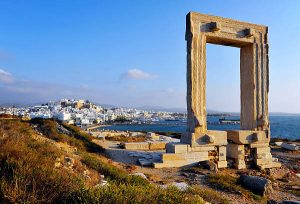
Naxos has enough beaches and tavernas to keep the average holidaymaker more than happy for a couple of weeks but those interested in the island’s history and culture will find plenty of historic buildings and places of interest to satisfy their curiosity.
The island is a haven for hikers and for those who prefer a gentle stroll down the high street there’s a wealth of jewellery, textiles, antique and souvenir shops to be found in Naxos Town.
Take the time to explore the old part of the town because it’s a delightful maze of winding, cobbled streets with flower filled balconies, archways and elegant old Venetian houses.
The medieval Kastro (castle) dominates the town, accessed by three entrances in its fortified outer wall. Visit the lovely 16th century Catholic cathedral at the centre of the Kastro, preferably on a Sunday morning when you can hear the strains of the choir through the open door and imagine yourself in another world from the bustle of the waterfront.
Behind the cathedral you’ll find the former French School of Commerce in a building where one of the country’s most famous literary sons Nikos Kazantzakis, who penned Zorba the Greek, once studied.
The building is now home to the Archaeological Museum which boasts a fine collection of treasures unearthed on the island including Cycladic figurines, fashioned from white marble, which are the earliest examples of Greek sculpture. The museum also has some beautiful Roman mosaics.
At the Venetian Museum, at the northern entrance to the Kastro, you can see inside a typical Kastro home, something you’ll be longing to do after you’ve prowled these fascinating jasmine-scented alleyways for a while.
The Mitropolis Site Museum, facing the town’s Orthodox Cathedral, is a subterranean room revealing the excavated site of a 13th century BC Mycenaean civilisation.
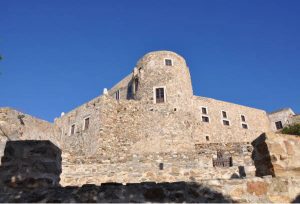
Filoti is the region’s largest village, perched on the slopes of Mount Zeus (also known as Mount Zas) which at 1,004 metres is the highest peak in the archipelago. If you’re feeling fit, you can make the half-hour trek from Filoti to see the Cave of Zeus where ancient tools and fragments of pottery have been found.
At Sangri, between Filoti and Hora, you can visit the 6th century BC Temple of Demeter, recently restored by German archaeologists.
Kouros statue at Apollonas
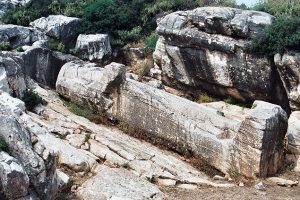
Their nakedness is a unique element, found only in Greek culture since the 8th century BC. The Egyptians had male sculptures but they, at least, wore a loincloth of some sort. These naked statues are important historically as they are free-standing for the first time in western art.
The best known statue on Naxos is the colossal kouros found near Apollonas, in the north-east, that dates from the 6th century BC. This kouros, lying on the hillside above the resort, is more than 10 metres from top to toe. Cement steps have been built alongside it to provide easy access for visitors that these days arrive by the bus load.
Curiously marked as a village on most maps, Melanes is actually the name of a valley directly east of Naxos Town, dotted with several hamlets and dense with fruit and olive trees.
It is best known for its own 7th century kouros which, at 6.4 metres, is smaller than its more famous neighbour at Apollonas. The figure is well signposted from the main road out of Hora and can be approached on the right just beyond the village of Mioi.
The kouros lies in a meticulously tended and lush private orchard, near a stream. Visitors are sometimes welcomed with drinks and fruit and the enchanting setting holds a charm that is missing from its more northern cousin.
The island’s second most famous kouros is at Flerio in the Melanes Valley. The 6th century statue, measuring eight metres, lies in a lovely private orchard and there’s another lesser-known kouros in a nearby field.
Towers of Naxos
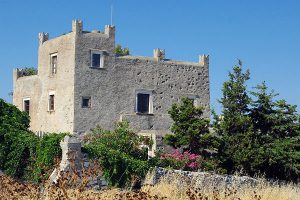
The Venetian towers were built with local stone, un-plastered and without any covering so that they blended into the surrounding countryside. The most important Venetian Towers are the Bellonia tower, built a little way out of the village Galanado; the towers of Gratsia and Markopoliti, in the area of Tragea; and the tower of Fragopoulos, in the village Kourounohori.
Many of the larger towers are surrounded by strong walls which once enclosed a courtyard, stables and storerooms. Doors and windows are often topped by sculpted marble lintels. They often had battlements built around the roofs. In Agia, about 6 km from the village Apollonas, is the Agia Tower located at a strategic spot near the most northerly point of the island.
Shopping in Naxos
When it comes to shopping in Naxos, you’ll find a variety of options ranging from local crafts and traditional products to fashionable items and souvenirs. The main town of Naxos, also known as Chora, offers a great shopping experience.
Wander through the narrow streets of the Old Town, where you’ll find numerous shops selling handmade crafts, jewelry, clothing, and artworks. Explore the market area near the port for local products like olive oil, honey, cheeses, and wines.
Located in the heart of Naxos Town, Agias Market is a covered market where you can find fresh fruits, vegetables, spices, and local delicacies. It’s a bustling place where locals and visitors come to purchase ingredients for their meals or to simply enjoy the vibrant atmosphere.
Naxos Town has a range of fashion boutiques and stores where you can find trendy clothing, accessories, and footwear. Explore the streets around the town center to discover stylish shops offering both local and international brands.
Naxos has a long tradition of pottery-making, and you’ll find several shops and workshops specializing in ceramic crafts. Look for handmade vases, plates, bowls, and other decorative items featuring intricate designs and vibrant colors.
Throughout Naxos, especially in popular tourist areas like Agios Prokopios and Plaka Beach, you’ll find numerous souvenir shops. These stores offer a variety of trinkets, postcards, magnets, and other memorabilia to bring back as mementos of your trip.
Naxos is known for its thriving art scene, and there are several art galleries on the island. You can browse and purchase paintings, sculptures, and other artworks created by local artists, often inspired by the island’s natural beauty.
If you’re looking to buy groceries or want to stock up on local products to take home, Naxos has supermarkets and delis where you can find a wide range of food items, including fresh produce, cheeses, olives, and traditional Greek products.
Naxos for families with kids
Naxos is a great destination for families with kids. Here are some specific reasons why Naxos is well-suited for families. Naxos offers numerous family-friendly beaches with calm waters and soft sand. Some popular options include Agios Prokopios Beach, Plaka Beach, and Agia Anna Beach. These beaches often have amenities like beachside tavernas, sunbed rentals, and water sports facilities.
Naxos provides opportunities for various water sports and activities that can be enjoyed by children. Kids can try their hand at windsurfing, paddleboarding, kayaking, or even take sailing lessons in a safe and supervised environment.
The Naxos Aqua Park is a popular attraction for families. It’s a water park with slides, pools, and water games suitable for both kids and adults. It offers a fun-filled day with plenty of entertainment and excitement for children.
Beaches
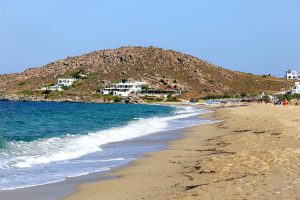
Lovers of water sports meet in the huge and organized in various places Plaka and surfers in Mikri Vigla.
The truly wonderful beaches, however, are further down to the south, on the peninsula with sand dunes and cedars at Alykos, the neighboring sandy Pyrgaki and the retro seaside settlement of Agiassos with its huge sandy beach and shallow waters.
For solitary dips, if you’re not afraid of the kilometers, head north-west to the shingle of Abraham’s Cove (where a small tourist settlement has developed) or head all the way east and down the winding road to Moutsuna beach. From here you can continue along the coast to the blue-green bay of Panormos for swimming with a view of the Small Cyclades.
How to move around Naxos
Roads on Naxos have much improved in recent years and there are any number of car and bike hire firms to choose from. Naxos is a big island and, although there is a decent bus service to the main villages, visitors need their own transport to see much of the island. The scenery is particularly beautiful inland especially around Aperanthos, Melanes, Apollonas and Danakos, the coast between Mikri Vigla and Pyrgaki and the area around Engares with a scenic east coast road from Moutsouna to Psili Ammos.
Public Buses
Naxos has a good bus service, although it is geared more to locals than tourists. The main bus station is near the port, close to the tourist information centre. Naxos buses leave every 30 minutes from the Hora to Prokopios, Agia Anna and Plaka. Inland, buses run to Halki, Filoti, Apiranthos and Apollona and there are also bus services to Keramouti, Koronoas, Melanes, Mikri Vigla, Moutsouna, Pyrgaki and Sangri.
Naxos bus services and times in English can be downloaded here and it’s a good idea to get a ticket before boarding. Services are operated by KTEL which also runs round-island tours in the summer.
Taxis
Taxis are available in Naxos and can be found at taxi ranks or hailed on the street. You can also ask your accommodation provider to arrange a taxi for you. Taxis are a convenient but relatively more expensive mode of transportation, especially for longer distances or remote areas. It’s advisable to confirm the fare with the driver before starting your journey.
Walking and hiking
Naxos is a terrific island for walking, crisscrossed by paths and donkey trails. The Naxos Tourist Office has a wide variety of maps of walking trails and its worthwhile seeking out copies of Naxos and the Small Cyclades by Graf Editions, which outlines 30 hikes, and Walking Tours on Naxos, by Christian Ucke, on sale in island bookshops. There are fairly accurate maps available in local shops. Roads Edition 111 and the Topo series are very good for planning walks. The roads are mostly asphalt and very quiet once out of Naxos Town and so fairly safe to walk.
Bicycle Rental
Naxos has bike rental services available, and cycling is a pleasant way to move around the island, especially in less congested areas. Some accommodations provide bicycles for their guests as well. Keep in mind that Naxos has hilly terrain in certain regions, so be prepared for some challenging routes.
Organized Tours
If you prefer a guided experience, you can join organized tours that take you to various attractions in Naxos. These tours often include transportation and knowledgeable guides who provide information about the island’s history, culture, and landmarks.
Where to stay
Naxos has a wide range of holiday accommodation. The choice includes quality hotels in Naxos Town to cheap rooms in many of the Naxos island resorts. If you arrive on Naxos without a reservation in high season expect to take pot luck with the many room owners that wave signs at ferry passengers in the port or try the tourist office on the Paralia promenade near the bus stop.
Naxos Town has plenty of reasonably priced rooms and many of hotels. Most of the holiday Naxos accommodation is centred around Agios Giorgios Beach on the southern edge of the town. Other beaches along the coast to Agios Prokopios, Agia Anna, Plaka and Kastraki also have some holiday accommodation.
Although there are plenty of self-catering apartments and villas to rent the accommodation can be very basic. Many apartments lie in the grounds of hotels so visitors can use the hotel facilities.
Naxos has always been popular with backpackers and the island has three well-equipped campsites. Naxos Camping is the oldest near Agios Giorgios beach. Maragas Camping also has studios and apartments while Plaka Camping offers discounts for students. All the sites have mini-markets, restaurants and laundries as well as minibuses to take campers to the ferry port.
How to get to Naxos
By Air
Naxos has no international airport but does take domestic flights at the small Naxos Airport (JNX), about two kilometres from Naxos town on the road to Prokopios.
Visitors can get a cheap flight to Athens where there are daily domestic flights to Naxos, with a flight time of about 30 minutes. There are ferry connections from the Athens’ ferry report of Piraeus and ferries usually leave early morning and another in the afternoon with crossing of five to six hours.
An alternative route is a flight to Mykonos or Santorini and one of the many ferries that leave daily for the island. Ferries of Santorini may depart later in the day, making a one-day journey to Naxos a possibility. Usually, however, these routes require an overnight stop on Mykonos and Santorini and flight and ferry times do not always coincide.
There are few facilities at Naxos airport, just a small waiting area, toilets and, recently, a cafe. There are frequent delays on departure and arrival. There is no public transport to and from Naxos airport but usually there are plenty of taxis outside to meeting incoming flights.
By Ferry
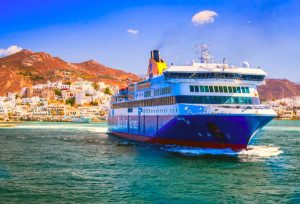
You can reach Piraeus Port from Athens city center by public transportation (metro, bus, or taxi) or by taxi directly from the airport. From Rafina Port, you can take a bus or a taxi from Athens International Airport or the city center.
It’s important to check the ferry schedules in advance, as they can be subject to change depending on the season. It’s also advisable to book your tickets in advance during peak travel periods.
